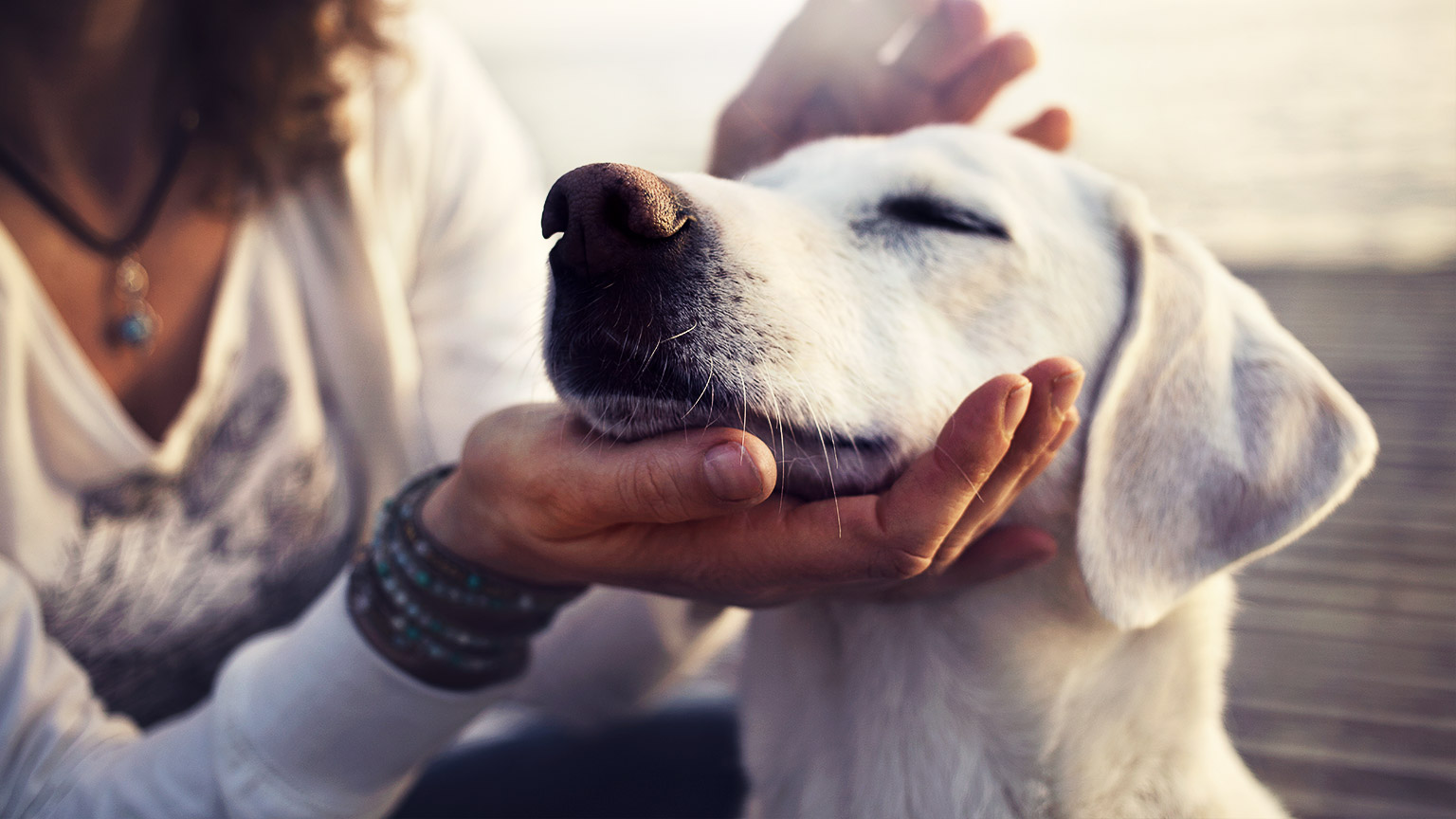When you consider working with animals, you must be prepared for the possibility of injury. But what do you think is one of the most common causes of injury to animal handlers?
The answer is poor handling technique. As with any of the animals discussed, always consider the need for handling before starting and select a method of restraint appropriate for the animal.
Before you approach an animal, you should be observing its demeanour. This means, you will need to observe the nature of the animal, for example, if you were handling a dog, does the dog bare teeth, or is it snarling or growling. It is not likely you will approach the dog and try to handle it if their teeth are baring, and they are barking aggressively at you. By assessing the demeanour of the animal, it will give you clues as to whether the animal is friendly, excitable, shy, nervous, or anxious and help you to modify your approach accordingly.
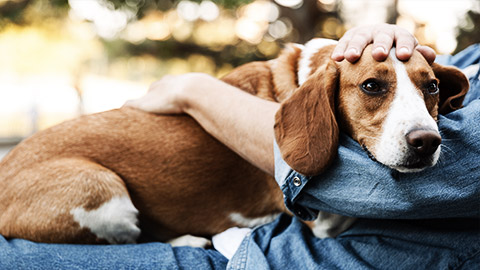
Dogs are easily excited and can be quite boisterous and generally respond positively to humans. Larger dogs can easily knock people over and bump into equipment and cause damage. Correct handling and restraint are essential to avoiding injury and damage. It is also important to never assume a dog is friendly, always conduct a thorough observation before approaching to avoid being bitten. If you do not feel confident in making this assessment, you should seek assistance from a more experienced colleague or a veterinarian. In the event you have consulted for someone else to help you, ensure you watch the vet (or another person) and the techniques they use to assess the dog, for example, they may talk gently to the dog, crouch down and allow the dog to sniff their hand before they try to handle it.
Preparation
Some vital steps need to be considered when you are preparing to move or handle a dog.
Approaching a dog
The techniques for approaching a dog in a kennel environment, follow similar techniques to that of when you are approaching a dog out of a kennel in the initial stages.
Tip
If the dog is presenting signs of over excitement, walk away from the kennel until the dog is calm. Usually turning your back to the dog and not showing attention will encourage the dog to calm down. This action may need to be repeated several times, depending on the nature of the dog.
When using a treat, tossing the dog the treat onto the floor before entering the kennel can serve as a distraction and enable you to enter the kennel. This also helps if the dog can be snappy when taking treats from the hand. Ensure when you are offering a treat as a reward you do so immediately after the dog has shown they are calm, even if it is just a few seconds.
Always remember if you are not sure or you do not feel confident, speak to senior staff or the veterinarian. It may also be a good idea for you to observe how experienced members of your team carry out this task to help develop your understanding.
Watch: How to Get Dog In/Out of Kennels (2:01 minutes)
The following video demonstrates the process for the kennel approach.
Post Watch Task: Write down any useful tips from the video for your own records.
Restraint
At any point when you are handling a dog, they will need to be restrained and the most common form of restraint is the use of a lead, collar and harness. Each of these is generally used in conjunction with one another however a leash can be used as both if need be. There is, however, a specific technique to apply the leash to use it as both leash and collar.
Collars and harnesses
There are several types of collars available for dogs, some even have the dual use of preventing fleas. Regardless of the type of collar chosen for the dog, you need to ensure it is fitted properly. If the collar is too tight you risk strangulation and the dog not being able to breathe properly and if it is too loose, you risk it slipping off the dog’s head and the dog having no restraint. In addition to a collar, you can use a harness. A harness slips over the dog’s head and under the arm pits and the leash is attached to the back of the harness. The harness, like the collar, must be fitted correctly to avoid the dog from being uncomfortable. If the harness is too tight it will rub under the dog’s armpit and may cause a rash and when it is too loose, it can result in less control when walking the dog.
Checking the collar
The collar should always be snug but not too tight, there is a simple way to check the collar and that is by using the two-finger rule. You can apply this rule by simply slipping your pointer and middle finger between the collar and the dog’s neck. You must regularly check the collar to make sure the fit is always correct.
The following diagram provides you with a labelled description of each part of a dog collar. It is important when you are using a dog collar it is neither too tight nor loose.
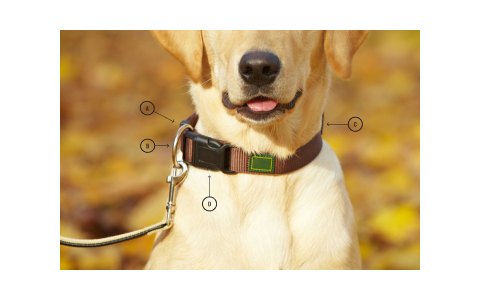
- Adjustable strap
- D-ring
- Strong buckle
- Identification tag holder
This table outlines the indicators of the collar and whether it is too loose or too tight. You should also note, the two-finger rule also applies to a harness. Place your pointer and middle finger between the top of the harness as you would with the collar.
| TWO-FINGER DESCRIPTIONS | INDICATOR |
|---|---|
| Fingers cannot fit between the collar and the dog's neck without force | The collar is too tight |
| Fingers slide easily but are snug between the collar and the neck | The collar is the right fit |
| Fingers slide effortlessly through the collar and the neck with room to spare | The collar |
Watch: How to fit the 5 main types of dog collars (2:12 minutes)
The following video illustrates the various types of collars that can be used for dogs and how best to fit and check them.
Post Watch Task: Write down any useful tips from the video for your own records.
Leash
A dog leash can come in various lengths and types and suitability will depend on what you need for the dog. Typically, you will be using a standard dog leash like the following image.

- D-ring
- Leash length
- Leash handle
The dog leash is one item you should always have on hand when restraining the dog. The length of the leash will help the level of control you have when you are needing to move the dog from one area to another. The longer the leash the further reign the dog will have, the shorter the lead, the less reign. Often, a shorter leash may be more suitable in animal care settings as you will need maximum control over the dog, especially when you are by passing other animals when moving them. When moving a dog out of a kennel or housing, you should never attempt to do it without a leash. To ensure you always have accessibility to the leash, you can have it stored outside the front of the kennel for easy use.
If the dog does not have a collar on, you can use the leash to help create both a collar and leash, this is as simple as creating a loop with the leash. Ensure when you have threaded the loop, it is roomy enough to slip over the dog’s head and minimises the risk of the dog biting you if they are known for being on the snappy side.
BE ORGANISED
When collecting a dog from a cage or run area it is important to think ahead and be prepared. Ensure you have everything you will need including:
- lead
- collar
- muzzle
KNOW YOUR ROUTE
Once you have the equipment you need, you must know where you are going that is what route you will take and check that the area is set up and ready to go- winging it and hoping for the best is not a good idea especially if you are handling a dog in an unfamiliar environment with unfamiliar people. You need to consider if you need to pass other animals make sure they are adequately contained/restrained- remember not all dogs play nicely with others.
CHECK THE DOORS
Ensure that any doors you are passing through to get to the area you need to have been checked. You will also need to ensure external doors are closed so the dog remains contained if it tries to escape.
SAFE APPROACH
When you are approaching the dog, always be aware of the dog's body language and overall behaviour and try to approach in a non-threatening manner. This is best achieved by allowing the dog to come to you whenever possible.
Normal behaviour for a dog includes:
- Wagging tail
- Relaxed or happy/playful
- Digging, chasing, barking and/or chewing.
Unusual behaviour for a dog includes:
- Panting.
- Lip licking.
- Whale eye (showing the whites of the eyes).
- Growling.
- Hiding.
Summary
- Be organised, ensure you have the leash ready to put on the dog before you open the gate. You should always have a treat on hand with you as a reward and distraction.
- Assess the behaviour of the dog from the outside of the kennel before you enter the space. Do not enter the kennel if you see the dog jumping at the gate or exhibiting aggressive behaviour. Wait for the dog to calm down before you enter.
- Wait for the dog is on all four legs and offer a treat for sitting.
- Gates both generally swing both ways- use the latch of the gate as a bolt ensuring the latch is positioned on the inside of the kennel and push the gate inwards in case the dog jumps. That way, the latch will prevent the gate from swinging.
- Use your body to help prevent the dog from lunging forward. Ensure you are standing directly in front of the gate with your feet firmly on the ground
- Enter the kennel closing the gate behind you.
- Pat the dog rewardingly and place the leash on the dog to prepare to walk it out. Make sure the lead is secure and will not slip off the dog.
- Ensure the dog is calm either sitting or standing before you exit the kennel.
- Proceed to exit.
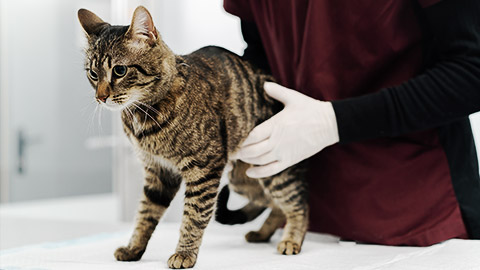
Cats can take a considerable amount of time to relax in new situations. You must take this into account when dealing with them and allow them some time to adjust to your presence before trying to handle them.
When handling cats, you should consider their well-developed sense of smell, and that they are very sensitive to loud noises and sudden movements. One way of doing this is to try and keep them in as familiar an environment as possible and avoid talking too loudly or making large gestures with your hands.
Preparation
You should always be organised before you attempt to move a cat. Cats can very easily become agitated and will often hiss and scratch if they are feeling threatened, especially when they are in unfamiliar territory. Some things to consider when preparing to handle/move a cat include:
- Transport them in their own carry basket with a familiar smelling object (such as a bed, towel or similar).
- Use an artificial feline facial pheromone (FFP), such as Feliway:
- FFP's replicate the happy scent that cats produce from the glands on their chin and forehead and use it to mark items that they like. Stroking that cat around its head can help to get this scent on your hands (if the cat will tolerate it).
- Artificial FFP's are currently available as a diffuser (to create a calming scent in the room) and a spray that can be used on the handlers clothing, holding cages and other objects. The FFP spray should be used at least 10 minutes before handling, as it has an alcohol base that must fully evaporate before the scent will be at full effectiveness.
- Before you get the cat out of the cage, ensure you have a clear route. Shut any doors to other rooms/areas, especially those that allow access outside. Restrain other animals, especially dogs (it is preferable to pick a path that avoids them).
Safe approach
Before you handle the cat, you must assess their behaviour. It is not advised you attempt to move a cat if they are showing signs of distress or fear. The following list provides you with some indicators of the general normal behaviour of a cat versus stress or unusual behaviours.
Normal behaviour for a cat includes:
- relaxed
- playful
- purring
- sleeping
Signs of stress or unusual behaviour includes:
- hiding
- hissing or growling
- swishing tail
- avoidance.
If the cat is showing signs of distress you need to give the cat as much time as you can to calm down before attempting to move it. Cats are known for wanting to do things in their own time, they will often take their time or hide before they are ready to be moved or even petted. Remain as calm as you can and use a soft voice and approach the cage slowly. When you approach the cage, rather than opening it immediately, gently put a finger through the cage and allow the cat to approach you and sniff your hand while gently talking to it. Ensure you have Feliway close by or on your clothing to encourage a sense of calm. Once the cat is calm, then you can attempt to move the cat.
Restraint
When restraining a cat there are some basic techniques you can apply. However, remember, cats can sometimes become scared easily. You must remain as calm as you can before attempting to restrain the cat.
The following are some examples of how you can restrain the cat if it is required.
- Three-fingered grip
The three-fingered grip or hold can be applied when restraining a cat for examination and is an alternative to scruffing. This technique is executed by using the whole hand on and positioning three fingers on the top of the cat’s head, you can gently massage or stroke the head of the cat to keep it calm during the examination. - Ring grip
In most cases, cats prefer as minimal restraint as possible. The ring grip can be used to help gently restrain a cat when they are being examined, especially if the examination requires checking of the neck. Place both your hands together so both of your pointer fingers and thumbs join to make a diamond or ring. Stand behind the cat and position your hands over the cat’s head with the ‘ring’ aligning just below the chin. Avoid applying too much pressure as this will scare the cat and it will become difficult to restrain it. - Towel wraps
In some cases, cats may like to be swaddled or wrapped in a towel. The towel often makes the cat feel secure and comfortable, particularly if the towel has Feliway sprayed on it before wrapping. Before you wrap the cat in a towel, ensure the towel is big enough to fully wrap around the cat. Be mindful, however, if you are using this restraining technique, you are aware that it does not eliminate the risk of the cat scratching or biting, however, it can minimise it.
Several wrapping techniques can be applied including however you have been provided with two of the most common examples of towel wraps- The burrito wrap where the cats head and neck are exposed but the rest of the body is wrapped in the towel
- The scarf wrap, similar to a cape, where the towel is used under the cat’s chest and wrapped behind leaving the front and hind legs exposed.
Cages
Finally, if the cat is displaying signs of distress, it may need to be restrained on a cage. Some cages are specifically designed so the veterinarian can administer an injection through the holes of the cage. If a cat is being moved or transported in a cage, it needs to hold blankets or towels with familiar scents and Feliway to help keep the cat as calm as possible while it is in there.
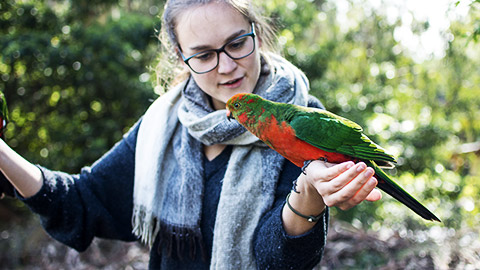
Bird handling can be quite tricky because birds stress very easily and excessive handling and chasing them can cause exhaustion and in extreme scenarios, death.
Preparation
The most important part of bird handling is in the initial stages and being prepared. Have a smaller cage or a box with a secure lid and adequate ventilation ready. Remove excess cage furniture as these not only create unnecessary obstacles when trying to catch the bird but also have the potential to injure a panicky bird.
Before you try to catch a bird make sure the room is secure, just in case they escape, and always have nets on hand.
Safe capture
Birds can interpret your body language so ensure you stay calm with no sudden movements. Always speak softly to the bird while you are approaching it and when you are handling it. If you are catching a particular bird out of a group, stay focused and try to separate it as quickly as possible. You may have to use a net if the bird is being captured from an aviary. However, if you are capturing a bird from a cage, it is advised you use a towel and avoid a firm grip around the bird because you may crush it. Gently rubbing your hand under the chest of the bird can also encourage the bird to climb onto your pointer finger. When possible, cup your hand around the bird, preferably closer to the neck rather than the chest to avoid obstructing the airways.
Restraint
Restraining the bird is the hardest part of bird handling. When you are attempting to restrain the bird, you will need to consider restrain the parts that can hurt you (talons/beak) and avoid putting pressure on the bird's chest and abdomen.
Where appropriate use restraint aids, such as tea towels or small bath towels, to reduce stress and chance of injury to the bird (and you). The technique you use will vary depending on the bird you are restraining.
If you are transporting a bird, consider whether you can transport it in its current cage. If you can, simply cover the cage with a towel or sheet to provide protection and reduce stress. Do not attempt to move the bird with only your hands or on the shoulder from one area to another, the bird may become distressed at any time and result in the bird flying away.
One of the most important things to remember when handling rabbits, mice and rats is that they are prey species. This means that you are automatically regarded as a potential predator and the animals will be very nervous and prepared to take flight.
For this reason, fast or sudden movements and loud noises should be avoided as they will further stress the animals and may cause them to take flight, which could result in them being dropped or falling from a height and injuring themselves if they are not correctly restrained.
Animals that have been kept as family pets may adjust to being handled more readily, but unexpected noises and sudden movements can still elicit this flight response.
Rabbit handling
Take your time, give the rabbit a few moments to adjust to your presence and it may relax and become easier to handle. Stroke their forehead, rabbits create bonds with other rabbits by social grooming, this can be replicated by your stroking it gently.
The correct rabbit handling technique is as follows:
- Never lift the rabbit by its ears or scruff.
- Turn the rabbit around so its bottom is facing the door of the hutch/cage.
- Take the chest in one hand to prevent forward movement and with the other hand manoeuvre the hind end towards you.
- Ensure you support the chest with your hand and the torso with your arm. Their spine must be supported.
- Tuck the rabbit's head under your arm, this will cover their eyes reducing their stress level.
- Always return the rabbit to its cage bottom first. If the rabbit is facing forward it may try to jump out of your restraint and could get injured.
Mice handling
Handling mice requires some speed and accuracy, as mice are very quick and chasing them around the cage trying to catch them can cause unnecessary stress.
One of the most common mistakes people make is trying to pick the mouse up by grasping it around its body. This is very threatening to a mouse as it replicates the sensation of being grabbed by a predator and the mouse will usually respond by wiggling to get away or by biting.
Remove all furniture from the cage, then pick the mouse up by the base of its tail. A mouse's tail can support its entire body weight but should only be held by the base as holding further down the tail may cause harm. Move the mouse as quickly as possible to avoid stress.
Once you have caught the mouse, support its body weight on your hand whilst holding on to its tail. Pet mice may be relatively tame and may sit on your hand quite happily without restraint - just remember mice are quick and a sudden noise or movement might frighten it, causing it to fall/jump off your hand or run up your sleeve (under your clothing).
Normal behaviour for a mouse includes:
- nesting
- exploring/playing
- foraging for food
- grooming.
Signs of stress or unusual behaviour includes:
- ruffled fur
- hunched posture
- hiding away from the group
Rat handling
Rats are very sensitive to their surroundings and will become nervous around people who are not confident with their handling skills. Where time permits, take a few minutes with the rat on your arm to allow it to adjust to your presence.
Picking a rat up is like picking a mouse up, however, a rat's tail cannot support its entire body weight. The rat should always be supported with your other hand. Remove all furniture from the cage and grasp the tail as close to the base as possible. The skin on a rat's tail is even more likely to be damaged, due to the additional strain created by the increased weight. Lift the rat's back legs and slide your free hand underneath the rat's body to support its weight.
Allow the rat to rest along your arm, whilst retaining a firm grip on its tail. Many rats will nestle comfortably in the crook of your arm and, as with mice, may not NEED to be physically restrained, although for safety reasons restraint should be maintained.
SOME THINGS TO CONSIDER WHEN HANDLING RATS INCLUDE:
- Handle them away from their cage. Rats have a well-developed 'homing' instinct and will try to return to their cage if handled within close proximity to it.
- Where possible handle them on smooth surfaces. Rats have quite delicate nails and the will catch and tear off readily on clothes and cage bars.
- Be firm but gentle. Rats are surprisingly strong and will pull out of the restraint if they are not held firmly enough.
Activity
For your assessment you will need to handle a cat, a dog and one of rabbits, birds or rodents. By now you should have spoken to your work placement supervisor about your practical assessment. Hopefully, you have even had some practice with handling animals under supervision.
As mentioned before, your practical assessment should not be the first time you apply your handling techniques – it takes time to get things right. Let’s make a plan for your assessment that you can show to your supervisor for feedback before the practical takes place.
Complete the tasks below. You will be able to save the information as a pdf and download it to your device. If you have access to a printer, a printed version may be useful to share with your supervisor, otherwise you should be able to use the copy on your device.
Good luck with your handling practice, we know you will do well. Our next topic is all about animal grooming, which we are sure you’re going to love.
